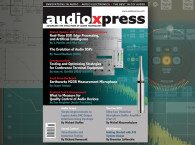 Our February 2021 edition explores one of the hottest product categories of the moment - microphones - while also continuing to detail the hottest technology trend in the audio industry, which is voice. With two related Market Updates in the same edition, audioXpress explains why Microphones have gained Essential Status in 2021, and how microphones have a foundational contribution to voice front-ends.
Our February 2021 edition explores one of the hottest product categories of the moment - microphones - while also continuing to detail the hottest technology trend in the audio industry, which is voice. With two related Market Updates in the same edition, audioXpress explains why Microphones have gained Essential Status in 2021, and how microphones have a foundational contribution to voice front-ends.
Committed to offering the most relevant content to our readers in these troubling and challenging times, audioXpress looks in-depth at microphones, one of the most disrupted product categories in 2020. The February 2021 edition of audioXpress explains why, and offers some examples of the companies who have successfully leveraged a totally new set of challenges, as the pandemic forced people to work from home, quickly adapt their daily workspaces to work remotely, and efficiently communicate on the web.
In "From Home to the World, Microphones Get Essential Status," we detail how the microphone industry was quick to respond to these trends, reacting to the exploding demand for microphones that could be used at home for webcasting, meetings, podcasting, voiceovers, or general home studio use.
In a separate feature, audioXpress explores what’s new in voice capture front-ends and voice interface development. A selection of recent platforms and solutions for voice technologies, which can be applied and directly benefit basic applications in communications or even dictation - areas that are now quickly changing because of the intense research in voice capture and recognition.
And further exploring the microphone topic for conference applications, in this edition Erica Yorga writes about Nureva's Microphone Mist technology in "Why Thousands of Virtual Microphones Matter: The Impact of Acoustic Spatial Resolution in a 3D Space." In this article, she explains in more detail why the (patented) concept of generating thousands of virtual microphones in a 3D space can be the ideal approach to creating perfect audio conferencing solutions in any type of room and with multiple users.
Following in audioXpress' tradition to go in-depth on Audio Electronics and product development, this month we initiate a new article series written by Mike Meechan, on "The Science and Physics of High-End Mic-Preamp Design." In this series, Meechan applies his extensive experience in designing low-noise pro-audio analog solutions, and investigates the principal mechanisms of noise, distortion, and interference that microphone preamplifier audio designers must understand, before exploring various circuit topologies used to maximize performance and minimize susceptibility.
audioXpress is also proud to feature a new type of review, which we expect to continue to explore in the future. In this article, headphone-review expert Brent Butterworth reviews the Widex Moment mRIC RD hearing aids. In a first for his career as a regular reviewer of headphones, hi-fi components, and other consumer audio products, Butterworth spent considerable time with the Widex Moment, one of the newest entries in the high-tech hearing aid category. And it's not because there was something wrong with his hearing, but because he was challenged by audioXpress to explore the manufacturer's claims that they sound "much more natural than other hearing aids," and can actually rival high-end headphones. audioXpress has been extensively following the evolution of true wireless stereo (TWS) earphones and the response from hearing aid companies to the new "hearables" category in the consumer space. This Fresh From the Bench article, objectively looks at the differences and similarities in the critical sound experience.
In Audio Scope, Michael Steffes continues to spread essential knowledge on audio electronics and integrated circuits. This month his article explains how to increase the output current for an audio op-amp by imbedding a unity gain buffer inside the loop where that buffer offers a much higher output current than the core op-amp. And he details a successful implementation using the recently updated TI BUF634A high-speed buffer and a JFET input OPA2810.
 For a great DIY project, Andrew C. Russell proposes the X-Altra, a highly refined Moving Coil/Moving Magnet RIAA EQ Preamplifier that we know our readers will treasure building (and owning). This high-performance phono equalizer features an ultra-low noise LSK389B JFET from Linear Systems in the MM front end with switchable gain and resistive loading. The MC front-end utilizes "current injection" input stage with Zetex ZTX851/951 bipolar devices for use with cartridges down to 3Ω coil resistance.
For a great DIY project, Andrew C. Russell proposes the X-Altra, a highly refined Moving Coil/Moving Magnet RIAA EQ Preamplifier that we know our readers will treasure building (and owning). This high-performance phono equalizer features an ultra-low noise LSK389B JFET from Linear Systems in the MM front end with switchable gain and resistive loading. The MC front-end utilizes "current injection" input stage with Zetex ZTX851/951 bipolar devices for use with cartridges down to 3Ω coil resistance.
Another great edition of audioXpress that we are certain readers will cherish for years to come. And another prime example of audioXpress' content, published 12 times per year and available in print and online. Subscribing to the digital online version allows immediate access at: www.audioxpress.com/page/audioXpress-Subscription-Services.html
If you wish to buy a single printed issue or the complete audioXpress archive on USB, from 2000 to 2021 (yes, including the latest issue), just visit our online shop at www.cc-webshop.com
Don't miss out, get your copy of audioXpress right now at www.gotomyxpress.com

- on Magazine News
- News
The Audio Technologies That Matter More Than Ever in audioXpress February 2021
January 11 2021, 07:10
audioXpress February 2021 explains why Microphones have gained Essential Status, and how microphones have a foundational contribution to voice front-ends. Erica Yorga details how Thousands of Virtual Microphones can solve audio conferencing challenges, and Mike Meechan explains how to design high-performance microphone preamplifiers. Brent Butterworth reviews the Widex Moment mRIC RD hearing aids to understand the differences and similarities in the critical sound experience. Michael Steffes explains how to increase the output current for an audio op-amp, and Andrew C. Russell details the X-Altra, a high-performance MC/MM phono equalizer DIY project. Now available in print and digital.





